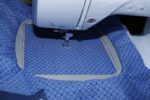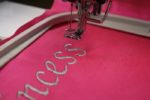Are you interested in learning how to embroider on canvas? Embroidery is an art, and it is something related to beautifying it by your needlework; it helps to turn the normal fabric or any other stuff into a decorated piece. Embroidery on canvas is possible. The material is already arranged in a precise manner which is easier to puncture by a needle.
Needlepoint is chipped away at even-weave material rather than texture. This material is like a wired network that is utilized in window screens. Both needlepoint material and wire network are equally woven, yet rather than wire, needlepoint material is made with long solid cotton or cloth filaments that are 100% normal. The material is adequately slim, and it’s ideal, assuming the region you need to weave is in the picture’s focal point.
How to embroider on canvas?
It is really simple to weave on material since it is the sort of material that nearly has weaving bands. You will see it simple to count the loops, and your fastens on the material. As far as how to do it, it relies upon the sort of join you use since the material is reasonable for a wide range of weaving. Your venture likewise directs your weaving style, i.e., regardless of whether you are putting it on a material sack or a clear workmanship material.
I have given you before a touch of thought regarding weaving material. Also, in this segment, gain proficiency with everything about achieving your venture. Try not to feel anxious if you have never attempted this strategy. Continue to practice, and you will ultimately get acquainted with it.
Step 1:
To set up my surface for spreading out, I squashed it well to kill any pleats as of late. Should your surface need crushing, turn it over with the target that you are pressing something in opposition to the surface, keeping away from the gets however much as could be expected.
Step 2 :
The extended material I picked was 3/4-inch thick, so I left around 2-½ creeps of texture past the edge of my cot bars on every one of the four sides. Whenever you’ve estimated everything, lay your weaving project face down on your work table and put your material face down on top of it.
Step 3:
Next, get one of your cover clasps, and folding one edge of the texture over your material casing, cut it set up along the focal point of one edge of the casing. Rehash this with every one of the four sides, fixing the texture on a case-by-case basis. You need your fabric to be quite tight.
Step 4:
Crease the squeezed piece of texture down a level, and pull the leftover corner texture down over it – the objective is to make the texture as close and level on the corners as could be expected.
Step 5:
At last, ensuring your texture is pulled tight, staple the corner set up. Rehash this interaction with every one of the four corners, and eliminate the cover cuts.
Step 6:
Working along the rear of the edge, pull the texture tight and staple it set up in the focal point of every one of the 4 sides. For best outcomes, work on inverse sides, as opposed to going around all around. Now you can either show your extended weaving or, on the other hand, if you’d like a neater back, continue to stage 9.
Step 7
To give your extended embroidery a neater completion on the back, cut out a piece of felt somewhat more modest than your extended material. Adding a line of paste around the felt, attach it to the rear of your material edge.
How to embroider letters on the material?
Letters might be accommodating; however, they give a “kick” to assist you with becoming inspired and more useful. That is the reason you ordinarily see them in the workplace and surprisingly in your workstation. Like pictures, sewing letters on material likewise includes making your plan, moving it on the material, and sewing. In any case, with a little uniqueness.
To begin, draw letters on the material with a pencil. String the needle with a line of floss and begin sewing following the lines. Super simple! Either handwrite letters or let the machine give you the layout. There are likewise free letter designs you can download on the web.
Need to make your craft more remarkable? I suggest adding a roll of line or rope over the letters you have outlined. Then, at that point, line over the trim. Make certain to conceal the line under the string. It is somewhat precarious; however, yet relax, you will cruise through it.
Fledglings can select more limited expressions or words. And keeping in mind that this venture burns through a lot of time, the last yield’s appealing measurement is excellent. Investigate various tones to satisfy your eyes.
To begin, draw letters on the material with a pencil. String the needle with a line of floss and begin sewing following the lines. Super simple! Either handwrite letters or let the machine give you the layout. There are likewise free letter designs you can download on the web.
What needle and string would it be a good idea for me to use for material?
Note that material arrives in a combination of loads. Along these lines, the needle and string you should utilize will likewise rely upon this. Lightweight material requires 60/8 needle size and incredible strings like upholstery and fleece. Weighty textures need 90/14, and 100/16 needle size and sturdy string produced using cotton or polyester.
Please note that material arrives in a combination of loads. Along these lines, the needle and string you should utilize will likewise rely upon this. Lightweight material requires 60/8 needle size and incredible strings like upholstery and fleece. Weighty textures need 90/14, 100/16 needle size, and sturdy string produced using cotton or polyester.
Supplies:
Following are the stuff that you will need for the embroidery process
Needle:
The material is extreme, so a sharp needle with a thicker base would be incredible, like a size 5. It is consistently interesting to suggest the ideal needle since I get a plain one from my muddled reserve. The investigation until you observe pushes through without lifting a finger and doesn’t leave an immense opening in the material.
Scissors:
Be certain that you are utilizing a matte that dries clear. I utilized the polished, and it was a little chaotic looking, except if you do the whole surface. I would not like to do that since I figured the watercolor would spread.
Froth brush to apply paste:
This is discretionary, truly, yet I do like it for equitably applying the paste. You could utilize an old paintbrush, and I’ve even utilized my fingers some of the time after all other options have been exhausted.
Weaving string:
I like to utilize the six abandoned cotton-weaving strings. Pick colors that supplement your composition.
FAQs
- Can you embroider on a canvas?
Fabric in an embroidery hoop is already stretched, so it is easier to embroider on canvas. Stitching is easy thanks to the canvas’ thin nature, which can easily be punctured with a needle. In order to have the embroidery appear to be in the center of the image, the area must be in the center of the picture.
- What type of canvas is used for embroidery?
Fabric replaces even-weave canvas in needlepoint, and the canvas resembles window screens made of wire mesh. In needlepoint canvas, the fibers are either cotton or linen, but the mesh is wire. Both are evenly woven, but needlepoint canvas composes strong long cotton linen fibers or fibers, which are 100% natural.
- How to embroider on canvas?
To get a detailed answer to this question, please give a look at our article. We provide complete information regarding how to embroider on canvas.
- What is needed for embroidery canvas?
The things you need are blank pre-stretched artist canvas, and we recommend 18 x 24 inches. Further, you need a ruler, needle, scissors, craft thread or embroidery floss, pencil, and eraser.
- Can you use watercolor on canvas?
It is usually impossible to use watercolors well on a traditional canvas, even if they are gessoed. It would not be easy to blend or overlay colors since the watercolors would easily peel off.
- Where do you start on a needlepoint canvas?
It depends on how you want to start a needlepoint canvas. To determine whether any work is being done, one generally begins at the center or as near to the center as possible. For printed or painted designs, you choose where to begin; it is up to you.
Conclusion
Embroidery is a very precious part of art, and it is useful to turn a simple piece of cloth into a unique piece. There are several ways to do embroidery, but the most appreciated one is by hand embroidery, embroidery on the material is simple. The material is now extended, actually like texture in a weaving loom. Material is adequately flimsy; it’s ideal assuming the region you need to weave is in the picture’s focal point. Now we are hoping that you learn how to embroider on canvas after a detailed review





